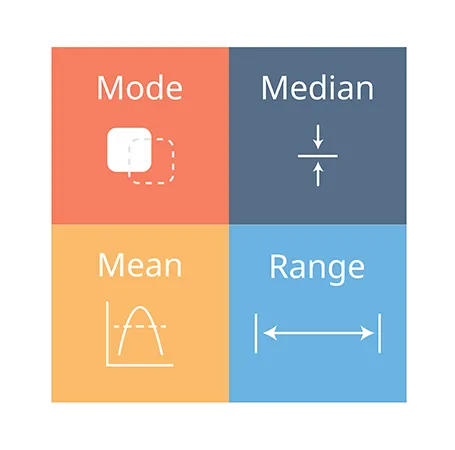Functional Skills
What is Modal in Maths? – How to Calculate and Formula?
We frequently use the model term in mathematics. But the question is what is the modal in maths? In a set of data, the modal or mode is the value that emerges the most in maths.
For example, consider the following numbers in order- 2, 2, 3, 3, 4, 5, 6, and 6; the modal number here is 3 because it appears the most number of times.
We can figure out the most common value by calculating the average. This could reveal something essential about the data set, making it quite useful.
Check out this blog to learn what is the modal in maths? And explore how to calculate and use formulas.
Table of Content
What is Modal in Maths?
Let’s define the mode for you here and also describe how to find the mode.
Primarily, in a data set, mode or modal value is the most common number. It’s useful in statistics since it may tell you which item in your set is the most popular. For example, you may have received a score of 1 to 5 on a customer satisfaction survey. Here, if the most popular response is 2, you know your customer service needs improvement.
What are Averages?
The average is the middle value of a group of numbers in mathematics. On the contrary, the median is the number in the middle of a group of values. Further, the average is the number in the middle. Here, if you need to get the average of a group of numbers, add them all up and divide by the number of numbers.
 Are you looking for a Functional Skills Maths Course?
Are you looking for a Functional Skills Maths Course?
How to Find Modal Average Maths?
So, how to calculate mode?
To find the modal average maths Order the numbers from lowest to highest and determine which number appears the most often. For example, If Eg 3, 3, 6, 13, 100 = 3, Then mode is 3.

Functional Skills Maths Level 2
What is a Modal class?
We can have more than one mode. For example, {1, 3, 3, 3, 4, 4, 6, 6, 6, 9}. 3 appears three times, as does 6. So there are two modes: 3 and 6. The presence of two modes refers to “Bimodal”.Having more than two modes is called “Multimodal”.

Functional Skills Maths Level 1 Course
Whether you are a beginner into the field of functional maths or any professional seeking to reinforce your expertise in functional skills maths, this Functional Skills Maths Level 1 Course will set you up with the advanced skills to boost your career profile.
Check out the blog to know what is functional skills equivalent to.
What is a Modal Interval?
An interval of nearest values for a measurement variable transpires noticeably more often than the values on each side of this interval.
A value that is regularly repeated in a data set is referred to as mode. To put it another way, this value appears more frequently in a data set. Further, the term “mode” is frequently used to describe a data set. Also, A class interval is the width of the group in the frequency table. Finally, the most often occurring class interval is known as the modal interval.
What is the Difference Between the Mode and the Modal Interval?
The modal interval is determined for ranges of numbers, while the mode is derived for individual numbers.
For example, assume the following set of numbers: 1, 2, 3, 4, 5, 6, 6, 6, 6, 13, 13, 13, 18, 22, 22.
Now, we’re going to divide that set into five intervals:
1-5: 5, 6-10: 4, 11-15: 3, 16-20: 1, 21-25: 2.
The number 6 is the mode (it appears four times), while the modal interval is 1-5. (which has five numbers, more than any other interval)
How to Work Out Modal in Maths?
The modal interval is determined for ranges of numbers, while the mode is derived for individual numbers.
For example, assume the following set of numbers: 1, 2, 3, 4, 5, 6, 6, 6, 6, 13, 13, 13, 18, 22, 22.
Now, we’re going to divide that set into five intervals:
1-5: 5, 6-10: 4, 11-15: 3, 16-20: 1, 21-25: 2.
The number 6 is the mode (it appears four times), while the modal interval is 1-5. (which has five numbers, more than any other interval)
Mean
To get the mean, you need to add all the numbers together and divide by the numbers. Mean is also known as average.
In addition, a quantity with a value halfway between the extreme members of a set is defined as the mean. Further, there are several types of means, and the procedure for determining one depends on the connection that governs the other members.
Median
In order from least to largest, the median is the midpoint number in your data set. Order the numbers and check which one is in the middle of the list to find the median. Subsequently, to analyse the method of the median first you need to sort your data.
Mode
The meaning of mode in maths is the number that occurred most often. Further, to identify the mode in math, sort the integers from lowest to highest and see which one shows most frequently. Lastly, the only average that can have no value, one value, or multiple values is the mode. Specifically, it’s easier to find the mode if you order the numbers first.
Range
The Range is the contrast between the highest and lowest values. In order to find the range, subtract the lowest value from the highest number. The mean and range maths have some differences, for example, the mean is not every time a whole number and the range is the gap between the highest and smallest number.
Mean is the average, on the other hand, the range is the difference between the highest and lowest numbers.
Top Courses of This Category
Meaning of Mode in Maths
The mode or modal is the value that appears most frequently in a set. In a data set, the mode or modal value is the value or number with high frequency or more appearance frequently
Apart from the mean and median, it is one of the three measures of central tendency. We can analyse the modal number meaning as the most common number in a data set.
It can help you to understand what is the most popular item in your set. That’s why it is useful in statistics.
The mode of the set 3, 7, 8, 8, 9 is, for example, 8. As a result, we can easily identify the model with a finite number of observations. A set of values can have only one mode, multiple modes, or none at all.
Tables, graphs, pie charts, bar graphs, pictorial representations, and other visual aids are used. After the data has been properly organised, it must be further processed in order to derive useful information.
The measure of central tendency is the name given to this representative value. It is implied by the term that it is a value around which the data is centred. We may generate a statistical summary of the enormous, ordered data using these metrics of central tendency. The mode of data is one such measure of central tendency.
Check out the blog to recognise how to get certification Functional Skills Maths Level 2 Course.
Conclusions
In summary, in a data set, mode or modal value is the most common number. It’s useful in statistics since it tells you which item in your set is the most popular. I hope this blog has provided you with a clear knowledge of modals in math as well as the formula and methods for calculating them.
FAQ
How do you find the modal in maths?
To find the mode, arrange the numbers in ascending order (to make counting easier), then count how many of each number there are. A mode is a number that appears frequently.
What is a modal math example?
An example of modal math is: The numbers 1, 3, 3, 3, 4, 4, 6, 6, 6, 6, and 9 appear three times, as does the number 6.
Are mode and modal the same thing in maths?
No. The term “mode” describes a data set. A class interval is the width of the group in the frequency table. The modal interval is the most often occurring class interval.
What is a modal class?
A modal class is the one with the highest frequency.
What is modal in data?
the mode or modal value is the most often occurring value in a data set.
What are mean mode and median and range?
In the data set, the mean is the average and the median is the midpoint number. The mode is the number that occurs most often and range is the contrast between the highest and lowest values.
What are mode and range?
Mode is the number that occurs the most often and range is the contrast between the highest and lowest values.
How do you find the range? Give an example.
Range is the difference between the lowest and highest numbers. For example, the lowest value in 4, 6, 9, 3, and 7 is 3, while the highest value is 9. As a result, the range is 9 3 = 6.
How do you find the mode?
To determine the mode, arrange the numbers from least to greatest and count how many times each number appears. The mode is the number that appears the most.
How do we calculate mode?
To calculate the mode, sort the integers from lowest to highest and see which one shows most frequently.
What is a class interval?
The difference between the upper and lower class limits is known as the class interval.
How do you find the class interval?
To find the class interval, we need to use the following formula:
Class Interval = Upper-Class limit – Lower class limit.
What to Read Next:
- What does Factorising Mean in Maths – Example of Factorising Mean
- What is an Identity in Math – Example of Identity in Math
- How to Get A and A* in Maths A Level – The Ultimate Guide
- What Does a Mathematician do – Working Areas and Responsibilities
- What is an Outlier Defined as A Level Maths?
- What Does Maths Stand for? Everything You Need to Know [MATHS]
- What is the difference between Maths and Further Maths? Details Explain




 Are you looking for a Functional Skills Maths Course?
Are you looking for a Functional Skills Maths Course?







